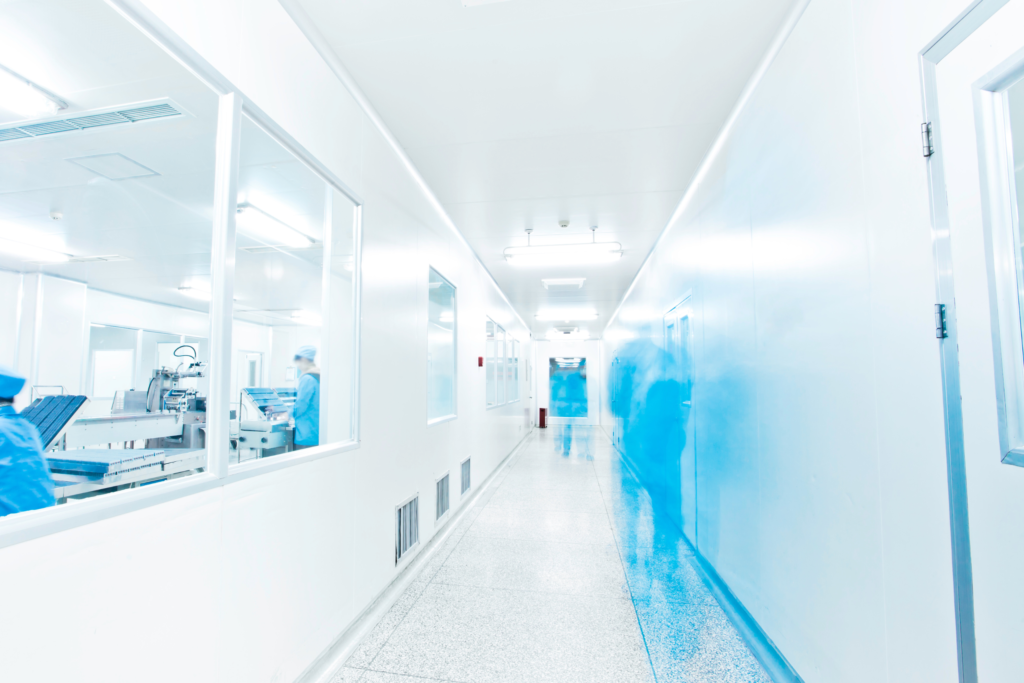Stick-built Cleanroom
What is stick-built cleanroom?
A stick-built cleanroom is a type of cleanroom that is constructed using traditional construction methods, where the cleanroom components are built from scratch on-site using raw materials. It is called “stick-built” because the cleanroom is assembled piece by piece, much like constructing a building using individual structural elements, such as studs, beams, and panels.

Advantages of stick-built cleanroom
In a stick-built cleanroom construction process, the following steps are typically involved:
Design and planning: The cleanroom design is created based on the specific requirements and needs of the facility. This includes determining the size, layout, classification (ISO class), airflow patterns, and necessary features such as air filtration, temperature control, humidity control, and particle monitoring.
Construction of the cleanroom shell: The structural framework of the cleanroom is built using materials such as metal studs, steel or aluminum frames, and panels. Walls, ceilings, and floors are constructed to meet the desired specifications and to provide the necessary structural integrity.
Installation of utilities: Once the shell is in place, utilities such as electrical systems, lighting fixtures, HVAC (heating, ventilation, and air conditioning) systems, plumbing, and data connections are installed according to the cleanroom design requirements.
Integration of cleanroom components: Specialized cleanroom components, such as air filters, pass-through chambers, air showers, cleanroom panels, windows, doors, and other fixtures, are installed to create the controlled environment within the cleanroom.
Validation and testing: Once the construction is complete, the stick-built cleanroom undergoes rigorous testing and validation processes to ensure that it meets the specified cleanliness standards, airflow patterns, and other performance parameters. This may involve particle count testing, air velocity measurements, pressure differential testing, temperature and humidity mapping, and microbial testing.
Stick-built cleanrooms offer the advantage of customization, as they can be tailored to meet specific requirements and accommodate unique layouts or site constraints. However, the construction process can be time-consuming and labor-intensive compared to modular cleanrooms. Additionally, modifications or expansions to stick-built cleanrooms may involve more significant disruptions and costs, as they require extensive construction work.
Comparison
Each type of cleanroom has its advantages and suitability depending on specific requirements, such as the desired level of cleanliness, flexibility, customization needs, budget, and project timeline. Choosing the right type of cleanroom involves considering these factors and assessing which option aligns best with your specific needs.
Construction | Flexibility | Installation | Cost | |
Modular Cleanroom | Modular cleanrooms are pre-engineered, prefabricated structures that consist of individual components or modules. These modules are manufactured off-site and assembled on-site. | They offer high flexibility and can be easily modified, expanded, or relocated according to changing needs. | Installation: Modular cleanrooms have a faster installation time compared to stick-built cleanrooms since they involve assembling pre-made components. | Cost: They tend to be more expensive initially due to the prefabrication and modular components, but they offer long-term cost savings due to their flexibility and reusability. |
Stick-Built Cleanroom | Stick-built cleanrooms are constructed on-site using traditional construction methods. They involve building the structure from scratch, including walls, ceilings, and floors. | They offer high customization options, allowing for precise design and integration with existing facilities or specific requirements. | Stick-built cleanrooms typically have a longer construction time compared to modular cleanrooms as they require on-site construction and coordination with various trades. | Cost: Initially, stick-built cleanrooms can be more cost-effective for small-scale projects, but they may involve higher costs for customization and modifications. |
Soft wall Cleanroom | Soft-wall cleanrooms are constructed using flexible materials like vinyl curtains or panels. They are typically suspended from the ceiling and form a barrier around the cleanroom area. | Soft-wall cleanrooms offer moderate flexibility and can be easily modified or expanded by adjusting the curtain or panel arrangements. | Soft-wall cleanrooms provide lower levels of cleanliness compared to modular or stick-built cleanrooms. They are suitable for environments where a lower level of control is required. | Soft-wall cleanrooms are generally the most cost-effective option as they involve minimal construction and use less expensive materials. |


